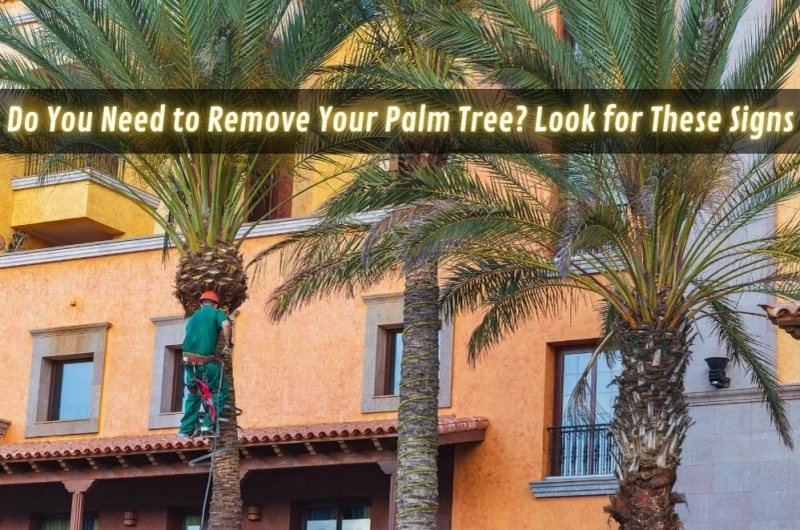Palm trees are common in the Australian landscape, especially in warmer climates like Melbourne, with their elegant fronds and tropical allure evoking images of coastal holidays and relaxed living. However, as with any living thing, It can have problems that might require removal. Knowing when to take this often drastic step is essential for the health of your property and the safety of those around you. This article will discuss the significant warning signs that will tell you if you need professional palm tree removal so that you can make the right decisions for your landscape.
Understanding the subtle cues is very important. Sometimes, seemingly minor issues represent significant underlying problems. Recognising these signs in advance can prevent further damage to your properties and dangerous situations. So, if you wonder, "Do I really need to remove my palm tree?" read on.
When to remove a palm tree: Key indicators
In such cases, tree decline results from numerous reasons, most subtler than the more apparent causes. The disease's early discovery sometimes allows its possible treatment in contrast to felling. Nonetheless, at other times, nothing but removing the infected area remains optional. Some generalised pre-mentioned warnings are observed to identify hazards for your trees.
Here are some of the warning signs that call for removing your palm tree:
- Sudden or significant leaf drop: Though some leaf drops are standard, a sudden or considerable loss of fronds is a sign of stress or disease.
- Changes in the crown: The crown refers to the top part of the palm where new fronds emerge. When the crown looks stunted, discoloured, or deformed, it could indicate a problem.
- The overall decline in vigour: A palm that generally looks unhealthy, with slow growth and a lack of vibrancy, may be struggling with an underlying issue.
- Fungal growth or insect infestation: Visible signs of fungal growth on the trunk or fronds or evidence of insect activity, like boreholes. It can be a sign of pest infestation or disease in your plants and trees.
Health declines: Signs of disease or structural damage
Trees are susceptible to various diseases and structural issues that can compromise their health and stability. Identifying these problems early is crucial.
- Ganoderma butt rot: This fungal disease attacks the base of the trunk, causing decay and weakening the tree’s structure. It's often difficult to detect until significant damage has occurred.
- Fusarium wilt is an infection of fungi within the palm vascular system that prevents water and nutrients from being transported inside. The common symptoms are frond wilting and discolouration.
- Infestation by pests: Weevils and scale insects may cause massive destruction to a palm tree. Pests will either bore inside the trunk or start eating the fronds, harming the palm tree by making it easy for diseases to develop.
- Trunk damage: Cracks, splits, or cavities that can significantly deteriorate a tree's internal structure are dangerous because they pose a high risk to overall safety.
Dangerous leaning: A safety hazard to address
While particular palms will present a very gentle lean, even a sudden angle change may result in a situation with a dangerous element. A leaning palm can fall during strong winds or storms, which are standard in Melbourne. The impact of dead trees on the environment will pose a danger to people, property, and structures around. To ensure safety and minimise risks of tree removal, immediately contact a professional arborist if you feel that your tree is leaning too much. They can explain what causes it to lean, which can result in professional removal if needed.
Inconsistent growth and nutrient deficiencies
Healthy trees must grow symmetrically and regularly. When palms stop growing, the fronds turn yellow or brown, or they fail to develop new fronds, there must be nutrient deficiency problems or worse.
- Potassium deficiency: This is the most common nutrient deficiency in palm trees, causing yellowing and necrosis of the fronds.
- Magnesium deficiency: This causes yellow banding on the fronds.
- Other nutrient issues: Other micronutrient deficiencies can also impact palm health.
While some nutrient deficiencies can be corrected with proper fertilisation, severe or chronic deficiencies weaken the tree, making it more vulnerable to disease and pests. Hence, a possible case for palm tree removal.
Visual cues for removal consideration
Another reason is aesthetics, which is significant if a tree is damaged or diseased. A severely injured, diseased, or unattractive tree in your landscape could be a good candidate for removal.
- Severely damaged fronds: When fronds consistently appear brown, broken, or infested, a palm tree can look unsightly.
- Poor growth and a sparse canopy: A slow-growing palm or a palm with an underdeveloped canopy offers little in terms of aesthetics.
- Unnatural shape or form: A diseased or damaged palm that assumes a strange shape or form will likely detract from the landscape.
Aesthetics alone are not an adequate reason to remove the palm, but they can play a part if other health or safety considerations apply.
Conclusion: balancing the decision to cut down palm trees
The decision to remove a tree is one of the most crucial decisions that will be made in a long time. All considerations must be carefully weighed, including its health, structure, and other safety risks it may pose. If any of the signs mentioned in the article above are observed, consult a professional arborist. They can examine the situation objectively and professionally and give advice. Early identification of problems may enable treatment, but it is not necessarily removal. On other occasions, such as severe disease structural damage or dangerous leaning, removal will be the only prudent course. Prioritising safety and the long-term health of your landscape is key. In some ways, tree removal can appear radical.


